Ralf Rangnick is one of the most famous head coaches in German top flight football. His work as a manager is seen as revolutionary since Rangnick was one of the first coaches to adapt a back four system in the Bundesliga.
Our tactical analysis will mainly look at his jobs at TSG Hoffenheim and his time at RB Leipzig since these were the clubs where he had most of his games as a Bundesliga manager.
In the course of our analysis, we are going to reveal some of Rangnick’s principles during the attacking phase and the defensive phase. Moreover, we explain how the German coach revolutionised the Bundesliga’s thinking about tactics and transition phases in particular.
Preferred systems
At Hoffenheim, Rangnick mainly used a 4-3-3. Looking at his whole coaching career though, Rangnick most often deployed a 4-4-2 system, which can turn into a 4-2-2-2 as illustrated in the graphic below. Another variant of a back four system he utilised is the 4-4-2 diamond which has a lot of similarities with the also centrally focused 4-2-2-2.
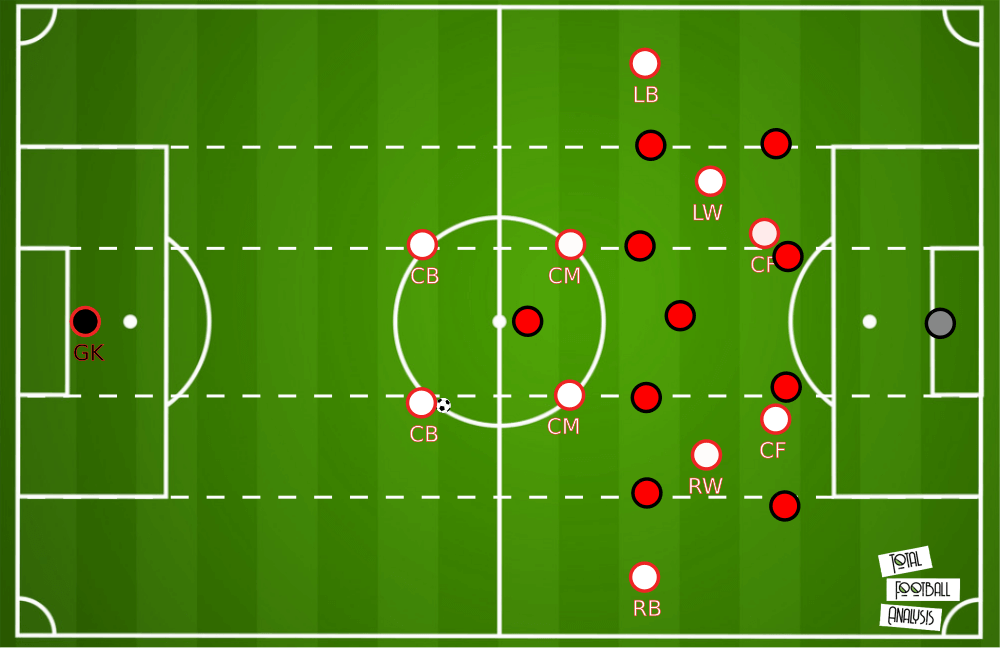
Later at RB Leipzig, Rangnick also utilised a 3-5-2 formation from time to time besides the preferred 4-4-2/4-2-2-2 system. Although their principles remained the same, Rangnick’s side would have one additional player in central midfield while still playing with two attackers. This enables two of them to press higher up the pitch while still one of them covers the space in front of the back line. This will allow them to outnumber opposition central midfielders rather than the opposition full-back during the defensive phase. How exactly they execute this, will be the main aspect of the following paragraph.
Pressing tactics
Rangnick watched Arrigo Sacchi’s AC Milan and adopted some of Sacchi’s principles such as the space-oriented and ball-oriented way of defending. Sacchi was an innovator of the pressing game, and with the adoption, Rangnick was one of Bundesliga’s pioneers when it came to the revolution from a sweeper system to a back four system.
When out of possession, Rangnick’s teams lately looked to press the opposition rather early than late in order to win the ball high up the pitch. This will then enable them to quickly transition into the attack and exploit the opposition disorganisation as close to the opposition goal as possible.
Concerning the pressing, Rangnick himself said that he wants to press the ball-carrier with a numerical advantage of at least one more player. In order to prepare this, they use certain traps where they lure the opposition into. A common theme that can be seen when depicting his press at Hoffenheim is to offer an open midfielder to then press with several players, ideally from the blind-side.
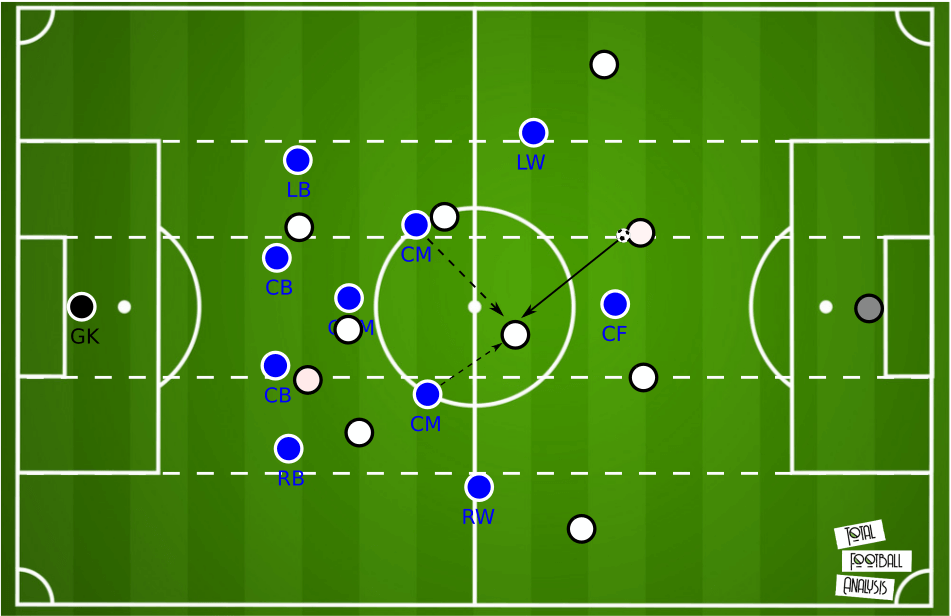
With their 4-3-3 system, they ensured to have enough midfielders to press in the centre of the pitch, while the wide positioning of the wingers forced the opposition to play into their trap.
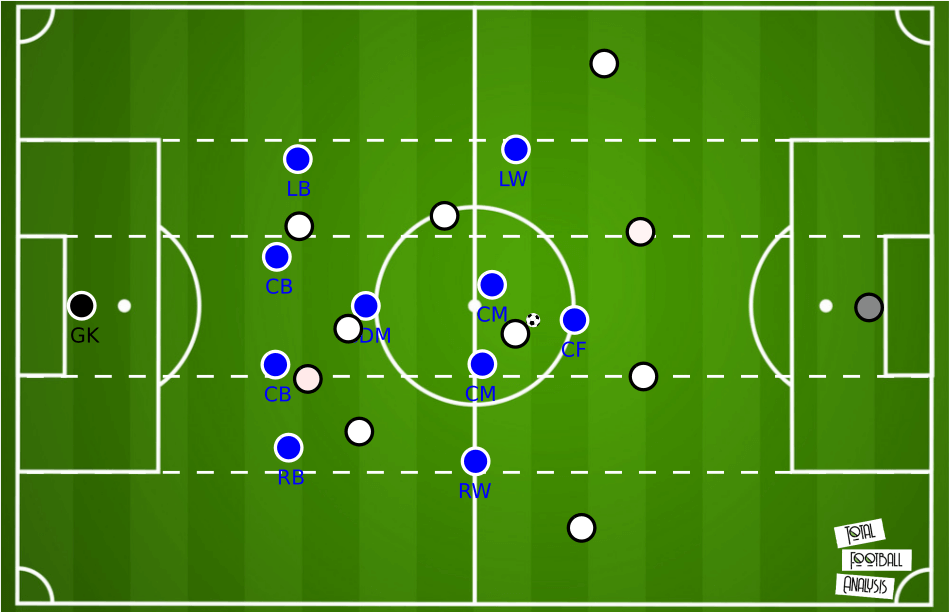
But besides their pressing traps they usually set up, Rangnick’s sides also possess certain pressing triggers. When observing their pressing mechanisms, one can see some similarities with Klopp’s current Liverpool. Square passes between centre-backs, for instance, would trigger their press starting with the winger pressing the receiving central defender and therewith forcing the opposition build-up towards the same side again.
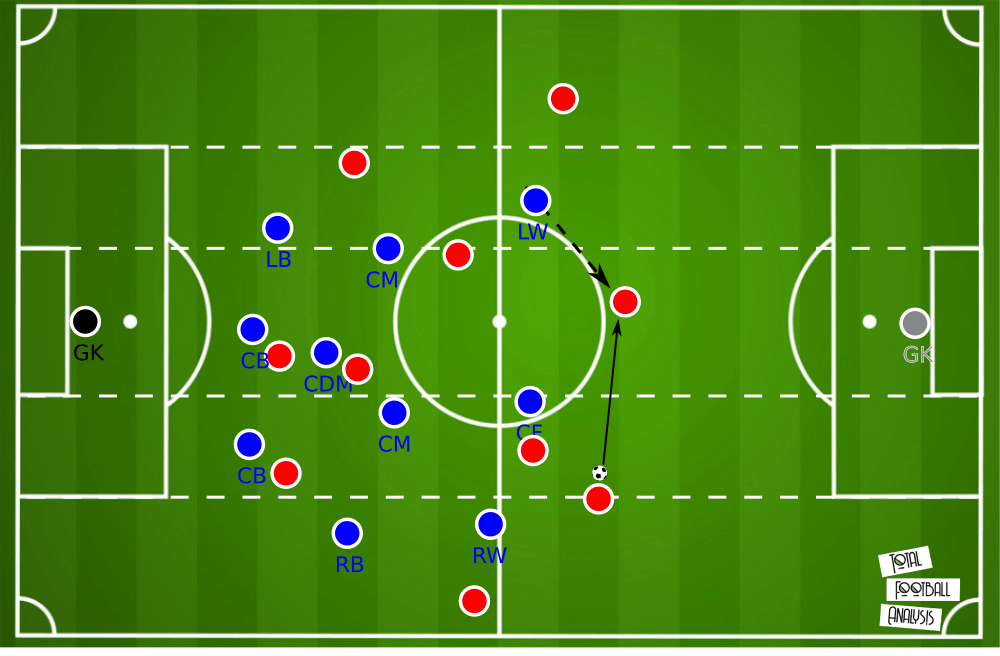
With the other winger now pressing the other centre-back, the opposition are often forced to play an imprecise forward pass which can be intercepted by a Hoffenheim midfielder within their narrow shape. Moreover, the ball near full-back often takes up a higher position in order to support the pressing if needed or to intercept a misplaced pass.
The main difference between the Hoffenheim press and the press during his recent Leipzig job is that his Hoffenheim side rather set up in a mid-block instead of pressing within the opposition half.
Within their 4-4-2 system at Leipzig, they would use simple pressing triggers such as a pass to the full-back and then collectively shift towards the ball side. By occupying only one quarter of the pitch, they will press the ball-carrier and shut down every single passing option. With a high pressing intensity they disable the opposition from switching sides and exploiting the space on the far side. Within their lines of four, they will cover each other with a diagonal staggering in order to prevent being overplayed. Their ball far central midfielder will cover the area in front of the back line, while their ball far centre-back safeguards the space behind the back line. When the back four was new to many in the Bundesliga, Rangnick said: “We don’t give up our sweeper, it just depends on the situation who our sweeper is” in the German “Sportstudio”.
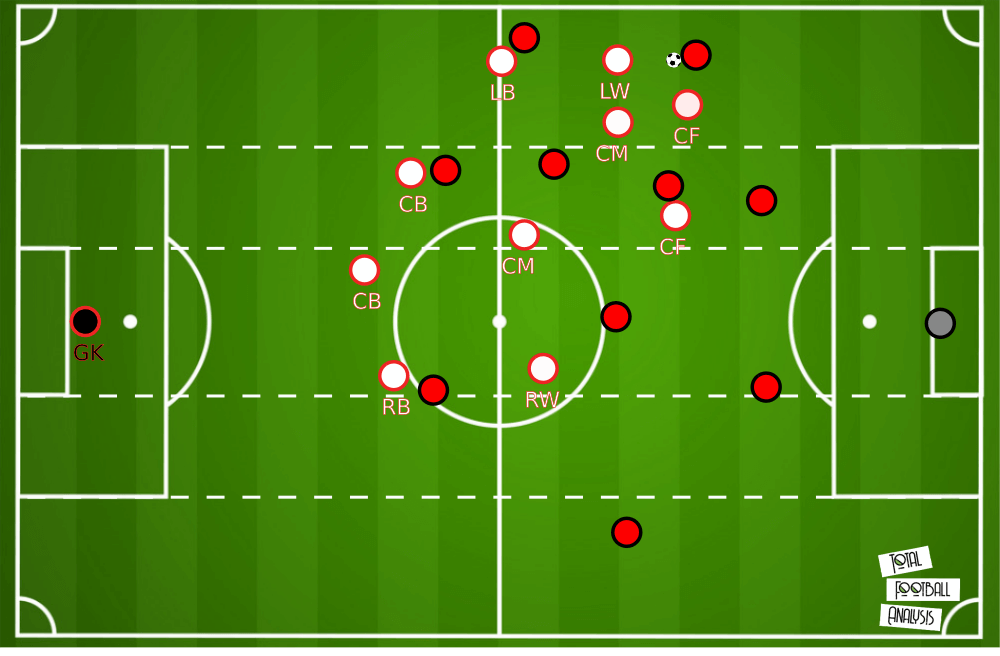
Similar to what most attacking sides do, Rangnick also wants his sides to create triangles during the press. This enables them to cover more space and opponents as they are not moving within each other’s cover-shadows.
Rangnick’s well structured pressing prepares for the threatening counter-attacks of his side which we will observe in the following paragraph.
Transition phases: Counter-attacking and counter-pressing
The principles during transition phases are among the key characteristics of Rangnick’s philosophy. And in his time at Hoffenheim, his side became known for their quick counter-attacks.
While vertical passes allowed them to quickly get towards the goal, square passes were avoided as they only wasted valuable time according to Rangnick. The German coach wanted his side to finish the counter-attack within under ten seconds since this is the time window with the bigger probability of scoring. In order to practice transition play, he even uses a clock with a count-down and the players can hear the ticking. That way, the ten-second rule for a shot on target is supposed to “become an instinct” according to Rangnick.
After regaining possession, they would immediately look for their most offensive player available. The wingers would quickly support the receiving player with deep runs. However, they only provide the maximum width needed as this shortens the way towards the goal.
Here we can see an example from Rangnick’s Hoffenheim where they play from their own box into Bayern Munich’s penalty area with only four passes after winning the ball.
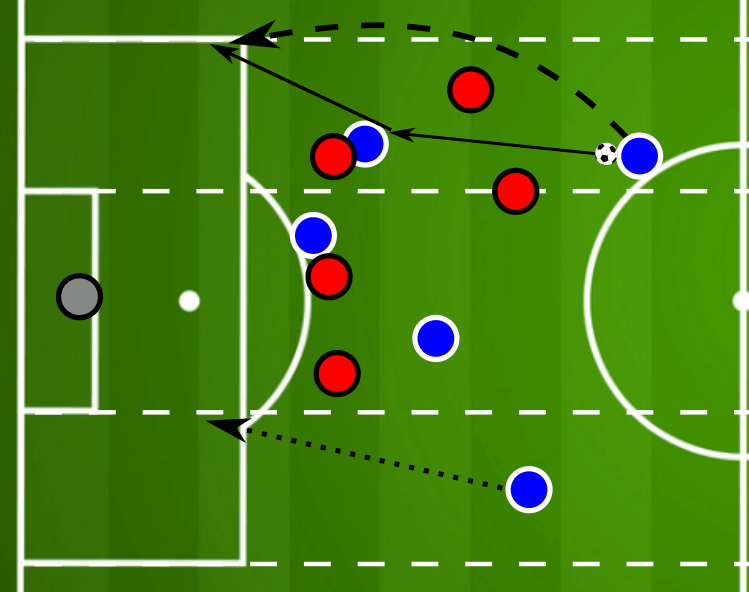
After the fifth and final pass, striker Vedad Ibišević can score the leading goal.
Similar to the offensive transitions, Rangnick also sees the defensive transition as a vital component of his game model. Compared to the offensive transitions though, the time window after the ball loss is shorter. Within eight seconds, the ball should be won back as this is the period of time where the opponents are still disorganised. And although many talks about Jürgen Klopp when it comes to Gegenpressing, the truth is that Rangnick also is an advocate of counter-pressing.
The narrow structure of his sides helps to keep the distances short. As a result, the players can quickly shift towards the ball after a loss, and therewith nip the opposition attack in the bud.
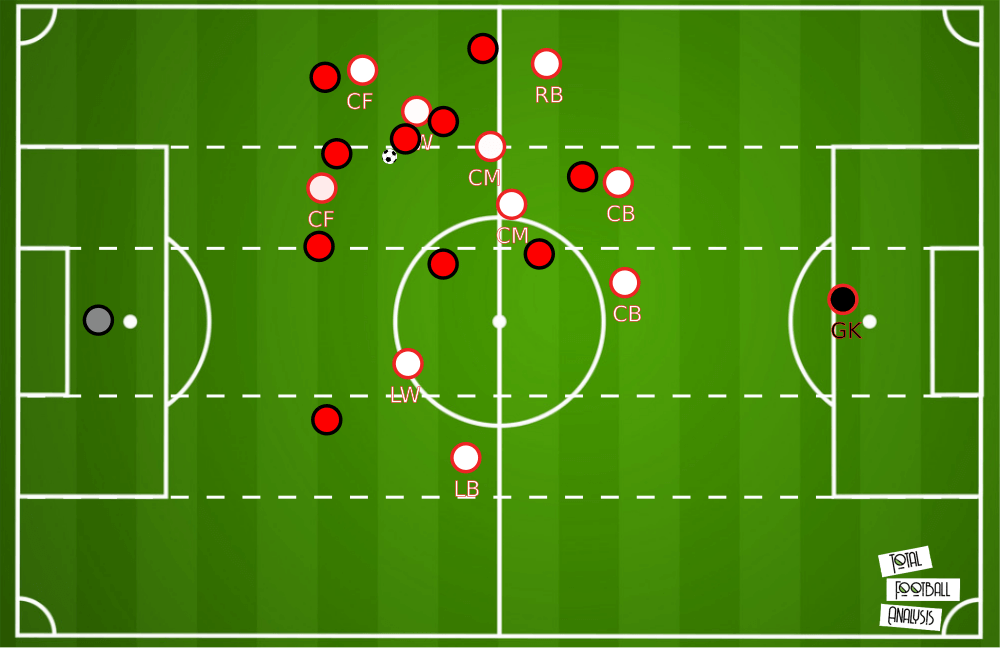
In addition to that, with winning the ball back during a counter-press the opportunity of a counter-attack arises.
Attacking principles
Rangnick’s attacking tactics revolve around quick vertical passes. Even during positional attacks, Rangnick’s teams try to threaten the opposition goal as early as possible. And the double pivot in front of the back line will ensure the needed cover during the attacking phase as ball losses are both, preprogrammed and taken into account by the former RB Leipzig coach.
Instead of deploying a positional play, Rangnick’s sides would rather aim at creating overloads, especially in the half-spaces. Through the creation of triangular structures and diamond shapes, they could then play with very few touches allowing combinations at a high pace.
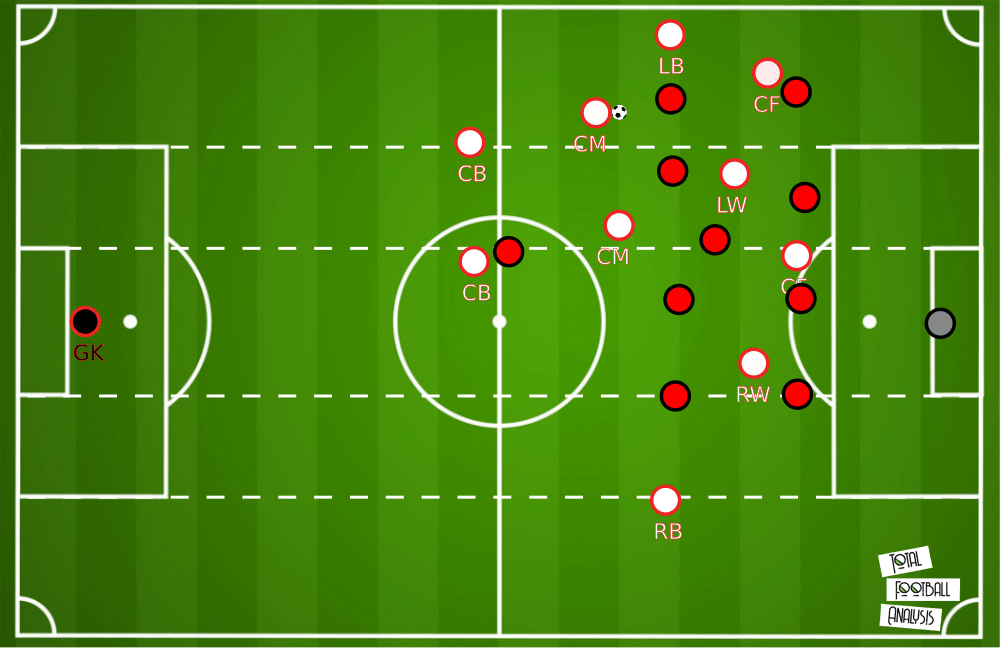
His sides usually play with striking duo up front. Their wingers will tuck inside and sometimes even act as playmakers behind the attacking duo. With his wingers turning into playmakers, the double pivot is not necessarily supposed to stay in central areas as there will always be enough options provided. Instead, they can then move wider and allow the full-backs to push higher up the pitch.
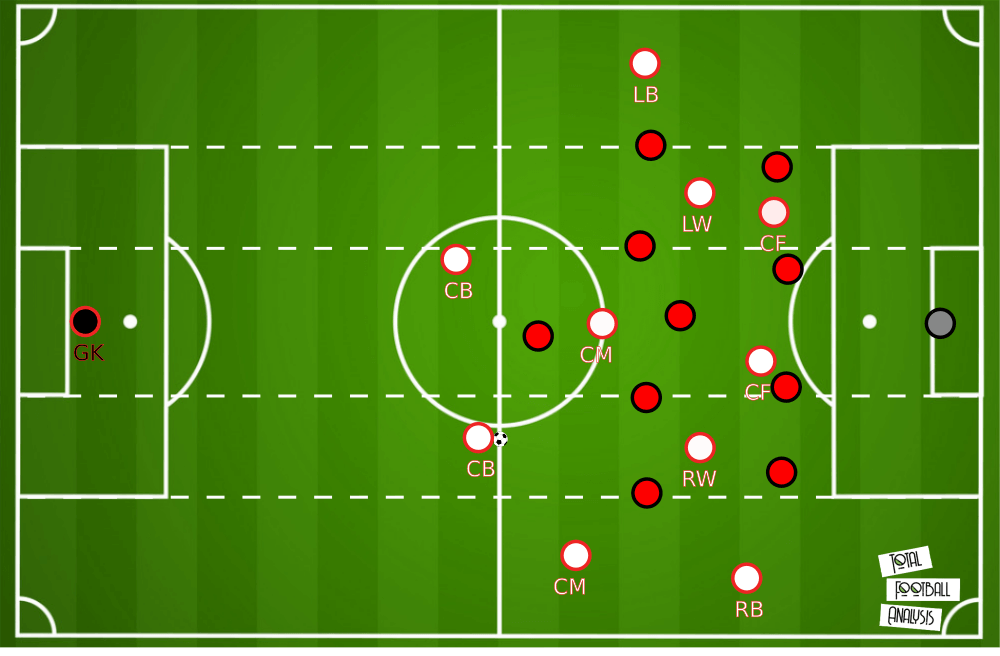
Since the defensive midfielders are not always occupying the same spaces, this flexibility makes it hard for the opposition to predict how Rangnick’s side will build-up their attack.
These inside-outside rotations make it difficult for the opposition midfield to cover all passing lanes. As a result, it often enables Rangnick’s teams to progress up the pitch through the half-spaces. With their attackers positioned within the central lanes, they can then quickly penetrate the opposition back line with through passes. Either played diagonally into a vertical deep run or vertically into a diagonal run.
They overload the space in front of the opposition back line. And not uncommonly, the opposition back line is in a dilemma whether to move out and open up a gap or to stay at the back enabling one of Rangnick’s offensive players to receive and turn.
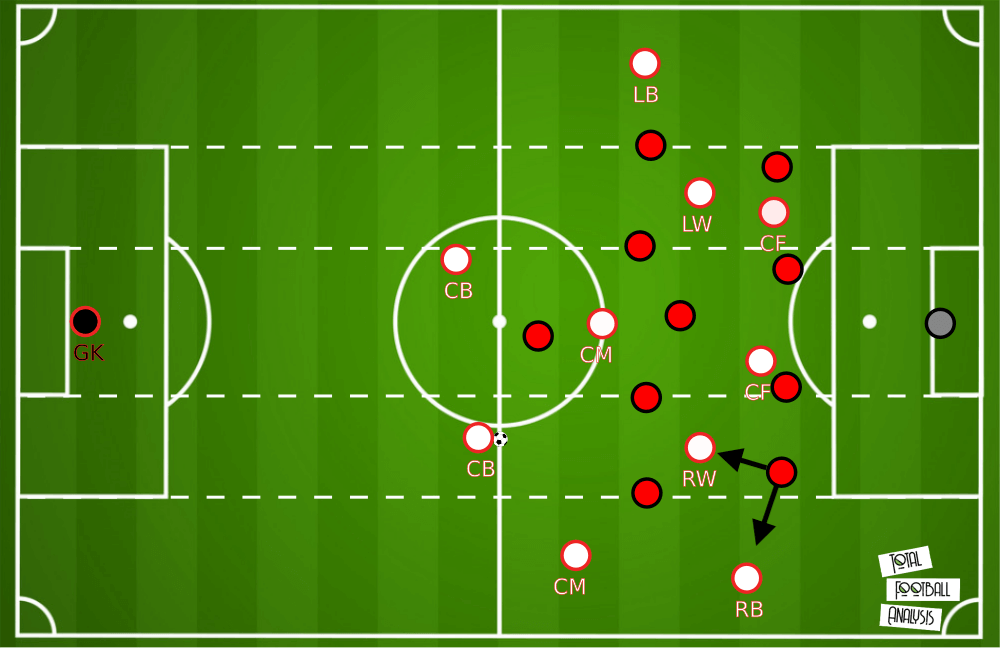
In having a lot of players up front with their attacking duo and at least their two playmakers, they have a setup that allows for effective counter-movements. While one player drops, another one is ready to exploit the space which opens up if the defender steps out.
Last but not least, their narrow attacking structure also forces the opposition to defend with a narrow shape in order to cover all passing lanes within the centre and the half-spaces. As a consequence, it opens up space on the flanks where their full-backs come into play. After playing out wide, Rangnick’s sides will either look to play into the half-space if possible or to provide a cross. With the high amount of players within the final third, Rangnick’s teams can then flood the box with attacking players making it hard for the opposition to mark every player.
Conclusion
Rangnick’s sides will not keep possession for the sake of possession. Neither will they sit back as a deep block to await a chance to regain possession. Instead, they will look to actively lure the opponent into pressing traps to win the ball with numerical superiority in certain areas. Once having won the ball, they aim at playing towards the opposition goal as fast as possible. During the possession phase, they will also look for the most vertical attacking options to always threaten the opposition. The idea lying behind all these principles is the chance of exploiting opposition disorganisation once having won the ball and the aim of decreasing the risk to lose possession with a wide and vulnerable attacking structure.
His style of play requires a lot of running, intensity, and physicality in general. Due to that, he prefers to play with relatively young squads. This enables his teams to recover more quickly and to keep up the high intensity in both, training and matches, throughout a whole season.
All in all, Rangnick is one of the most interesting coaches on the market at the moment. And with his experience combined with his innovative thinking, the German head coach could be an attractive coach for many top clubs even outside of Germany.
You are going to love what Total Football Analysis are bringing you this weekend.
Starting with the Reiverderby in the German Bundesliga this coming Saturday, May 16 – Total Football Analysis will be bringing you live match commentary and analysis of Borussia Dortmund vs Schalke, kicking off at 14:30 UK.





Comments